Operator’s Manual
IMPORTANT: Read this manual carefully. It contains information about your safety and the safety of others. Also become familiar with the controls and their proper use before you operate the product.


IMPORTANT: Read this manual carefully. It contains information about your safety and the safety of others. Also become familiar with the controls and their proper use before you operate the product.

Thank you for purchasing a Toro product.
All of us at Toro want you to be completely satisfied with your new product, so feel free to contact your local Authorized Service Dealer for help with service, genuine replacement parts, or other information you may require.
Whenever you contact your Authorized Service Dealer or the factory, always know the model and serial numbers of your product. These numbers will help the Service Dealer or Service Representative provide exact information about your specific product. You will find the model and serial number plate located in a unique place on the product as shown below.
The warning system in this manual identifies potential hazards and has special safety messages that help you and others avoid personal injury, even death.
DANGER, WARNING and CAUTION are signal words used to identify the level of hazard. However, regardless of the hazard, be extremely careful.
DANGER signals an extreme hazard that will cause serious injury or death if the recommended precautions are not followed.
WARNING signals a hazard that may cause serious injury or death if the recommended precautions are not followed.
CAUTION signals a hazard that may cause minor or moderate injury if the recommended precautions are not followed.
Two other words are also used to highlight information. “Important” calls attention to special mechanical information and “Note” emphasizes general information worthy of special attention.
The left and right side of the machine is determined by sitting on the seat in the normal operator’s position.
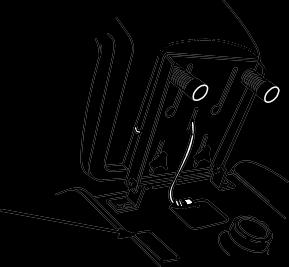
For your convenience, write the product model and serial numbers in the space below.
Model No: Serial No.
Read this manual carefully to learn how to operate and maintain your product correctly. Reading this manual will help you and others avoid personal injury and damage to the product. Although we design, produce and market safe, state-of-the-art products, you are responsible for using the product properly and safely. You are also responsible for training persons, who you allow to use the product, about safe operation.
The engine exhaust from this product contains chemicals known to the State of California to cause cancer, birth defects, or other reproductive harm.
IMPORTANT: The engine in this product is not equipped with a spark arrester muffler. It is a violation of California Public Resource Code Section 4442 to use or operate this engine on any forest–covered, brush–covered or grass–covered land as defined in CPRC 4126. Other states or federal areas may have similar laws.
The enclosed Engine
supplied for regarding The U.S. Environmental Protection Agency (EPA) the California Emission Control Regulation of emission sy maintenance and warranty. Keep this engine Owner’s Manual with your unit. Should engine Owner’s Manual become damaged or illegible, rep immediately. Replacements may be ordered through the manufacturer.
This machine meets or exceeds the B71.1–1996 specifications of the American National Standards Institute, in effect at the time of production. However, improper use or maintenance by the operator or owner can result in injury. To reduce the potential for injury, comply with these safety instructions and always pay attention to the safety alert symbol, which means CAUTION, WARNING, or DANGER “personal safety instruction.” Failure to comply with the instruction may result in personal injury or death.
This product is capable of amputating hands and feet and throwing objects. Always follow all safety instructions to avoid serious injury or death.
3. Clear the area of objects such as rocks, toys, wire, etc., which could be picked up and thrown by the blade.
4. Be sure the area is clear of other people before mowing. Stop the machine if anyone enters the area.
5. Never carry passengers.
6. Do not mow in reverse unless absolutely necessary. Always look down and behind before and while backing.
7. Be aware of the mower discharge direction and do not point it at anyone. Do not operate the mower without either the entire grass catcher or the guard in place.
8. Slow down before turning. Sharp turns on any terrain may cause loss of control.
• Engine exhaust contains carbon monoxide, which is an odorless, deadly poison.
• Carbon monoxide can kill you and is also known to the State of California to cause birth defects.
• Do not run engine indoors or in an enclosed area.
1. Read, understand, and follow all instructions in the operator’s manual and on the machine before starting.
2. Allow only responsible adults who are familiar with the instructions to operate the machine.
9. Never leave a running machine unattended. Always turn off blades, set parking brake, stop engine, and remove the ignition and “Key Choice” keys before dismounting.
10. Turn off blades when not mowing.
11. Keep hands, feet, hair and loose clothing away from attachment discharge area, underside of mower and any moving parts while engine is running.
12. Stop the engine before removing the grass catcher or unclogging the chute.
13. Mow only in daylight or good artificial light.
14. Do not operate the machine while under the influence of alcohol or drugs.
15. Watch for traffic when operating near or crossing roadways.
16. Use extra care when loading or unloading the machine onto a trailer or truck.
17. Do not touch equipment or attachment parts which may be hot from operation. Allow to cool before attempting to maintain, adjust or service.
Slopes are a major factor related to loss-of-control and tip-over accidents, which can result in severe injury or death. All slopes require extra caution. If you cannot back up the slope or if you feel uneasy on it, do not mow it.
• Mow up and down slopes greater than 5 , not across.
• Mow downhill only on slopes above 10, never mow uphill. If a steep slope must be ascended, back up the hill, and drive forward down the hill, keeping the machine in gear.
• Remove obstacles such as rocks, tree limbs, etc. from the mowing area. Watch for holes, ruts or bumps, as uneven terrain could overturn the machine. Tall grass can hide obstacles.
• Use slow speed. Choose a low gear so that you will not have to stop or shift while on the slope.
• Followthemanufacturer’srecommendations for wheel weight or counterweights to improve stability.
• Use extra care with grass catchers or other attachments. These can change the stability of the machine.
• Keep all movement on slopes slow and gradual. Do not make sudden changes in speed or direction.
• Avoid starting or stopping on a slope. If tires lose traction, disengage the blades and proceed slowly straight down the slope.
• Do not operate machine on hillsides or slopes exceeding 15
• Avoid turning on slopes. If you must turn, turn slowly and gradually downhill, if possible.
• Do not mow near drop-offs, ditches, or embankments. The machine could suddenly turn over if a wheel goes over the edge of a cliff or ditch, or if an edge caves in.
• Do not mow on wet grass. Reduced traction could cause sliding.
• Do not try to stabilize the machine by putting your foot on the ground.
• Do not use a grass catcher on steep slopes. Heavy grass bags could cause loss of control or overturn the machine.
Tragic accidents can occur if the operator is not alert to the presence of children. Children are often attracted to the machine and the mowing activity. Never assume that children will remain where you last saw them. The following requirements must be followed to prevent injury to children.
1. Keep children out of the mowing area and under the watchful care of another responsible adult.
2. Be alert and turn the machine off if children enter the area.
3. Before and while backing, look behind and down for small children.
4. Never carry children. They may fall off and be seriously injured or interfere with safe machine operation.
5. Never allow children to operate the machine.
6. Use extra care when approaching blind corners, shrubs, trees, the end of a fence or other objects that may obscure vision.
1. Stop the engine, disconnect spark plug wire(s) and remove key before performing any service, repairs, maintenance or adjustments.
2. Use extra care when handling gasoline and other fuels. They are flammable and vapors are explosive.
A. Use only an approved container.
B. Never remove the gas cap or add fuel when the engine is running. Allow the engine to cool before refueling. Do not smoke.
C. Never refuel the machine indoors.
D. Never store the machine or fuel container inside where there is an open flame, such as near a water heater or furnace.
3. Never run a machine inside a closed area.
4. Keep nuts and bolts tight, especially the blade attachment bolts. Keep equipment in good condition.
5. Never tamper with safety devices. Check safety systems for proper operation before each use.
6. Keep the machine free of grass, leaves, or other debris build-up. Clean up oil or fuel spillage. Allow the machine to cool before storing.
7. Stop and inspect the equipment if you strike an object. Repair, if necessary, before restarting.
8. Grass catcher components are subject to wear, damage and deterioration, which could expose moving parts or allow objects to be thrown. Frequently check components and replace with manufacturer’s recommended parts, when necessary.
9. Mower blades are sharp and can cut. Wrap the blade(s) or wear gloves, and use extra caution when servicing them.
10. Use only genuine replacement parts to ensure that original standards are maintained.
11. Check brake operation frequently. Adjust and service as required.
12. Battery acid is poisonous and can cause burns. Avoid contact with skin, eyes and clothing. Protect your face, eyes and clothing when working with a battery.
13. Battery gases can explode. Keep cigarettes, sparks and flames away from battery.
Read all safety instructions on pages 2–4.

Safety decals and instructions are easily visible to the operator and are located near any area of potential danger. Replace any decal that is damaged or lost.
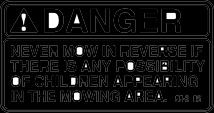
ON STEERING TOWER (Part No. 93–0302)
ON FRAME STEP (Part No. 92–8946)
DASH INDICATOR PANEL (Part No. 99-8036)
ON FRAME CENTER REAR (Part No. 92–6727)
ON FRAME RIGHT REAR (Part No. 92–6726)
ON DASH LEFT SIDE (Part No. 92–6720)
ON DASH RIGHT SIDE (Part No. 92–6721)
ON LIFT LEVER (Part No. 112168)
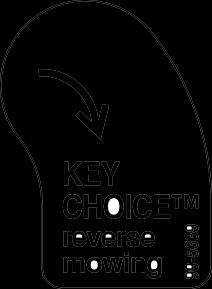
ON STEERING TOWER (Part No. 83–6620)
ON FRAME STEP (Part No. 92–6725)
ON DIAL-A-HEIGHT KNOB (Part No. 78–9740)










ON SEAT BRACKET (Part No. 99-2985)
ON SEAT BRACKET (Part No. 99-5339A)
Recommended Gasoline
Use UNLEADED Regular Gasoline suitable for automotive use (85 pump octane minimum). Leaded regular gasoline may be used if unleaded regular is
not available.
IMPORTANT: Never use methanol, gasoline containing methanol, or gasohol containing more than 10% ethanol because the fuel system could be damaged. Do not mix oil with gasoline.
POTENTIAL HAZARD
• In certain conditions gasoline is extremely flammable and highly explosive.
WHAT CAN HAPPEN
• A fire or explosion from gasoline can burn you, others, and cause property damage.
HOWTO AVOIDTHE HAZARD
• Use a funnel and fill the fuel tank outdoors, in an open area, when the engine is cold. Wipe up any gasoline that spills.
• Do not fill the fuel tank completely full. Add gasoline to the fuel tank until the level is 1/4” to 1/2” (6 mm to 13 mm) below the bottom of the filler neck. This empty space in the tank allows gasoline to expand.
• Never smoke when handling gasoline, and stay away from an open flame or where gasoline fumes may be ignited by a spark.
• Store gasoline in an approved container and keep it out of the reach of children. Never buy more than a 30-day supply of gasoline.
POTENTIAL HAZARD
• In certain conditions gasoline is extremely flammable and highly explosive.
WHAT CAN HAPPEN
• A fire or explosion from gasoline can burn you, others, and cause property damage.
HOWTO AVOIDTHE HAZARD
• Always place gasoline containers on the ground away from your vehicle before filling.
• Do not fill gasoline containers inside a vehicle or on a truck or trailer bed because interior carpets or plastic truck bed liners may insulate the container and slow the loss of any static charge.
• When practical, remove gas–powered equipment from the truck or trailer and refuel the equipment with its wheels on the ground.
• If this is not possible, then refuel such equipment on a truck or trailer from a portable container, rather than from a gasoline dispenser nozzle.
• If a gasoline dispenser nozzle must be used, keep the nozzle in contact with the rim of the fuel tank or container opening at all times until fueling is complete.
Add the correct amount of gas stabilizer/conditioner to the gas. Using a stabilizer/conditioner in the machine:
• Keeps gasoline fresh during storage of 90 days or less. For longer storage it is recommended that the fuel tank be drained.
• Cleans the engine while it runs
• Eliminates gum-like buildup in the fuel system, which causes hard starting
IMPORTANT:Neverusefueladditives containing methanol or ethanol.
1. Shut the engine off and set the parking brake.
2. Clean around each fuel tank cap and remove the cap. Add unleaded regular gasoline to both fuel tanks, until the level is 1/4 to 1/2 inch (6 mm to 13 mm) below the bottom of the filler neck. This space in the tank allows gasoline to expand. Do not fill the fuel tanks completely full.
3. Install fuel tank caps securely. Wipe up any gasoline that may have spilled.
4. Fuel gauge is located in right side tank.
Before you start the engine and use the machine, check the oil level in the engine crankcase; refer to Checking Oil Level, page 23.
Please carefully read all the safety instructions on pages 2–7. Knowing this information could help you, your family, pets or bystanders avoid injury.
Become familiar with all the controls (Fig. 1) before you start the engine and operate the machine.
A turn and release switch used for deactivating the “Operating–In–Reverse” interlock feature. Located on the seat bracket on the right hand just below the seat (Fig. 2).
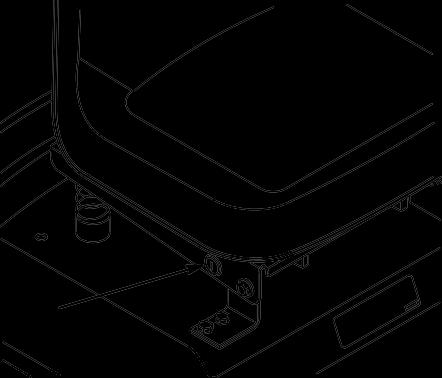
Always set the parking brake when you stop the machine or leave it unattended.
1. Push the brake pedal (Fig. 3) down and hold it in the depressed position.
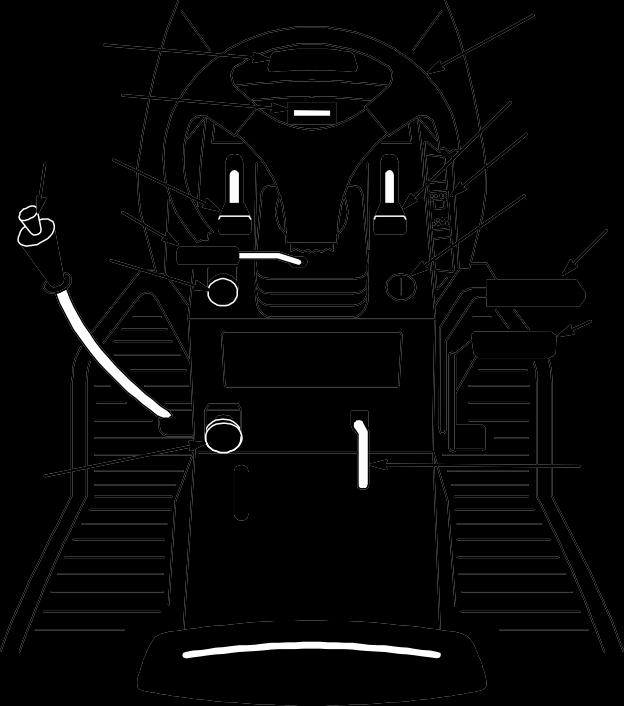
2. Lift the parking brake lever (Fig. 3) up and gradually take your foot off the brake pedal. The brake pedal should stay in the depressed (locked) position.
1. Push down on the brake pedal (Fig. 3). The parking brake lever should release.
2. Gradually release the brake pedal.
Starting
1. Sit down on the seat.
2. Set the parking brake; refer to Setting the Parking Brake, page 10.
Note: The engine will not start unless you set the parking brake or fully depress the brake pedal and are seated.
3. Push the PTO (power take off) to “OFF” (Fig. 4).
4. Move the choke lever to “ON” (Fig. 4).
Note: An engine that has been running and is warm may not require step 4.
5. Move throttle lever to “FAST” (Fig. 5).
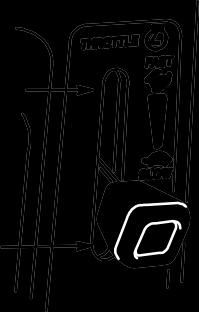
6. Turn the ignition key clockwise and hold it in the “START” position (Fig.6). Whenthe engine starts, release the key.
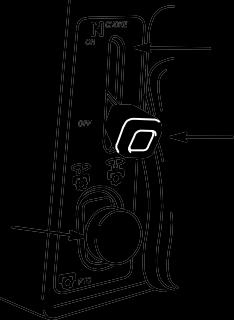
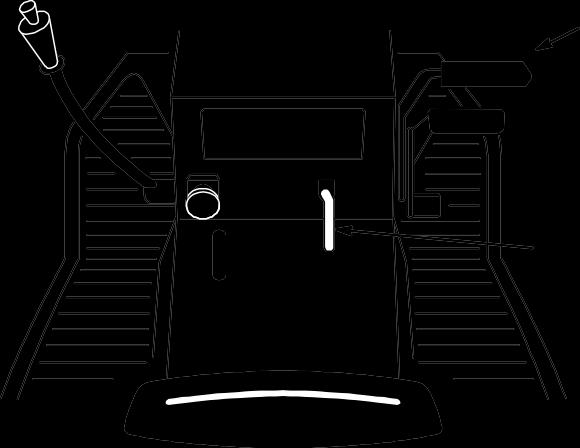
IMPORTANT: If the engine does not start 1 after 30 seconds of continuous cranking, turn the ignition key to “OFF” and let the starter motor cool; refer toTroubleshooting, page 39.
7. After the engine starts, move the choke lever to “OFF” and slowly move the throttle to the desired setting (Fig. 5). If the engine stalls or hesitates, move the choke lever back to “ON” for a few seconds. Then move the throttle lever to desired setting. Repeat this as required.
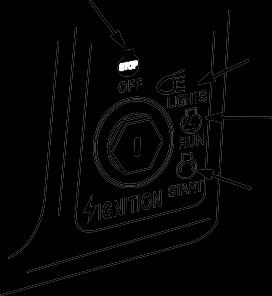
1. Move the throttle lever to “SLOW” (Fig. 5).
2. Turn the ignition key to “OFF” (Fig. 6).
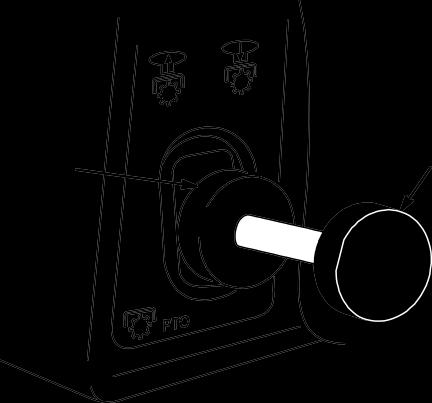
Note: If the engine has been working hard or is hot, let it idle for a minute before turning the ignition key “OFF.” This helps cool the engine before it is stopped. In an emergency, the engine may be stopped by turning the ignition key to “OFF.”
The power take off (PTO) engages and disengages power to the electric clutch. While the ignition key is in “RUN” or “LIGHTS”
position and the power take off (PTO) is engaged “ON”, the PTO light, in the Indicator Module, will be “ON”. When this light is “ON” it is a reminder the starter will not crank and to turn the off PTO before getting off the tractor.
1. Depress the brake pedal to stop the machine.
2. Pull the power take off (PTO) to “ON” (Fig. 7).
2.
1. Depress the brake pedal to stop the machine.
2. Push the power take off (PTO) to “OFF” (Fig. 7).
The safety interlock system is designed to prevent the engine from starting unless:
• You are sitting on the seat
• The brake pedal is depressed
• The power take off (PTO) is “OFF”
• On gear drive models the speed selector lever is in “N” neutral.
The safety interlock system is designed to stop the engine if:
• You rise from the seat when the brake pedal is released
• You rise from the seat when the power take off (PTO) is “ON”or gear selector is not in “N” neutral.
The safety interlock system is designed to stop the power take off (PTO) if:
• You shift into reverse with the power take off (PTO) engaged.
An interlock feature is provided that prevents the Power Take Off (PTO) from operating while the tractor is traveling in reverse. If the unit is shifted into reverse while the mower blade or other PTO driven attachment is engaged, the PTO will stop. Do not mow while backing up unless it is absolutely necessary. If you need to mow while in reverse gear or use other PTO driven attachments
(such as a snowthrower or tiller), this operating–in–reverse interlockfeature may be temporarily deactivated.
Before deactivating this feature, be sure there are no children present on or near the property where you are using the tractor, and that none are likely to appear while you are mowing or operating an attachment. Be extra observant after you have chosen to deactivate the interlock feature because the sound of the tractor’s engine might prevent you from being aware that a child or a bystander has entered the area where you are operating the tractor.
If you are certain that you can safely mow in reverse or operate an attachment, deactivate the operating–in–reverse interlock feature by turning the “Key Choice” switch (Fig. 8), located on the seat bracket on the right hand side just below the seat, after engaging the blade (PTO). A red light on the front console (Fig. 9) will turn on as a reminder that the operating–in–reverse interlock has been deactivated. Once the interlock is deactivated it stays in this mode with your mower blade or PTO–driven attachment operating whenever you back up and the console light stays on until either the blade (PTO) is disengaged, or the engine is turned off.
Note: Do not insert the “Key Choice” key unless it is absolutely necessary to mow in reverse or operate and attachment. The “Key Choice” key should also be removed from the unit if it will be operated by someone other than a responsible, experienced operator. This will prevent the unit from operating in reverse with the mower blade or other PTO attachment engaged. Always remove both the ignition and the “Key Choice” keys and put them in a safe place out of the reach of children when leaving the unit unattended.
• A child or bystander could be backed over by a riding mower with its blade(s) engaged.
• Blade contact will cause serious personal injury or death.
• Do not mow in reverse unless absolutely necessary.
• Always look backward and down before backing up.
• Use “Key Choice” switch only if you are certain no children or other bystanders will appear in the mowing area.
• Always remove both the ignition and “Key Choice” keys and put them in a safe place out of the reach of children or unauthorized users when leaving the unit unattended.
1. Set the parking brake. Move the power take off (PTO) to “ON”. Now turn the ignition key to “START”; the engine should not crank.
2. Push the power take off (PTO) to “OFF” and release the parking brake. Now turn the ignition key to “START”; the engine should not crank.
3. Set the parking brake and move the power take off (PTO) to “OFF”(On gear drive models the speed selector lever must be in “N” neutral). Now start the engine. While the engine is running, release the parking brake and rise slightly from the seat; the engine should stop.
4. With the parking brake released, turn the ignition key to RUN without starting the engine. Pull the PTO switch to ON. You should hear an audible click indicating the PTO is activated and the PTO light will illuminate. Move the foot pedal to reverse. You should hear an audible click indicating the PTO is deactivated and the PTO light should turn off.
5. With the parking brake released, turn the ignition key to RUN without starting the engine. Pull the PTO switch to ON. You should hear an audible click indicating the PTO is activated and the PTO light will illuminate. Move the foot pedal to reverse. You should hear an audible click indicating the PTO is deactivated and the PTO light should turn off.
6. With the parking brake released, turn the ignition switch to RUN without starting the engine. Pull the PTO switch to ON. Turn the “Key Choice” key and release. The Operating–in–Reverse warning light should illuminate. Move the foot pedal to reverse. The PTO and PTO light on the dash should remain on. Push the PTO switch to OFF. The PTO light and the
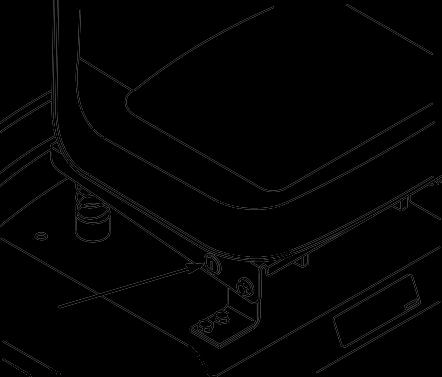
Test the safety interlock system before you use the machine each time. If the safety system does not operate as described below, have an Authorized Service Dealer repair the safetysystem immediately.
Operating–in–Reverse warning light should turn off.
The indicator control module (optional on some models) (Fig. 9) lights when the parking brake or power take off (PTO), is actuated and when there is a problem of low oil pressure or alternator output, that needs immediate attention.
The battery light will be “ON” when the key is in the “RUN” or “LIGHTS” positions if the battery voltage is below 12.6 volts or when the engine is running and the alternator output is above 14.8 volts. When this light comes on it is important to have your battery and electrical system checked and the problem corrected.
The hourmeter (optional on some models) records the number of hours the engine has operated (Fig. 9). It is turned on when the ignition switch is in the “RUN” or “LIGHTS” positions. Use the times for scheduling regular maintenance.
Following are the conditions when indicator lights will be “ON”. At other times the lights should be off.
The Operating–in–Reverse light will illuminate whenever the “Key Choice” switch is used to deactivate the operating–in–reverse interlock. It is a reminder that the interlock system is deactivated. The light goes out whenever the power take off (PTO) is disengaged or the engine is shut off.

The oil light will be “ON” when the key is in the “RUN” or “LIGHTS” positions and the engine is not running, after the engine is started the light should go out. When the engine is running if the oil pressure drops below a safe operating level the light comes “ON”. When the light comes on while the engine is running, Stop engine immediately and correct the cause of low oil pressure.
The PTO (power take off) light will be “ON” when the key is in the “RUN” or “LIGHTS” positions and the PTO (power take off) is engaged “ON”. When this light is “ON” it is a reminder; the starter will not crank and turn off the PTO before getting off.